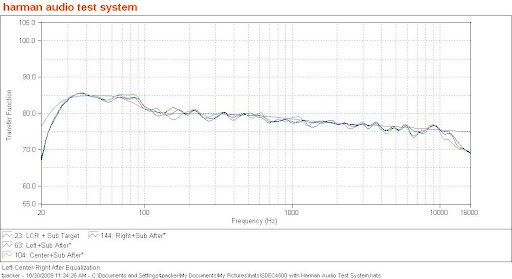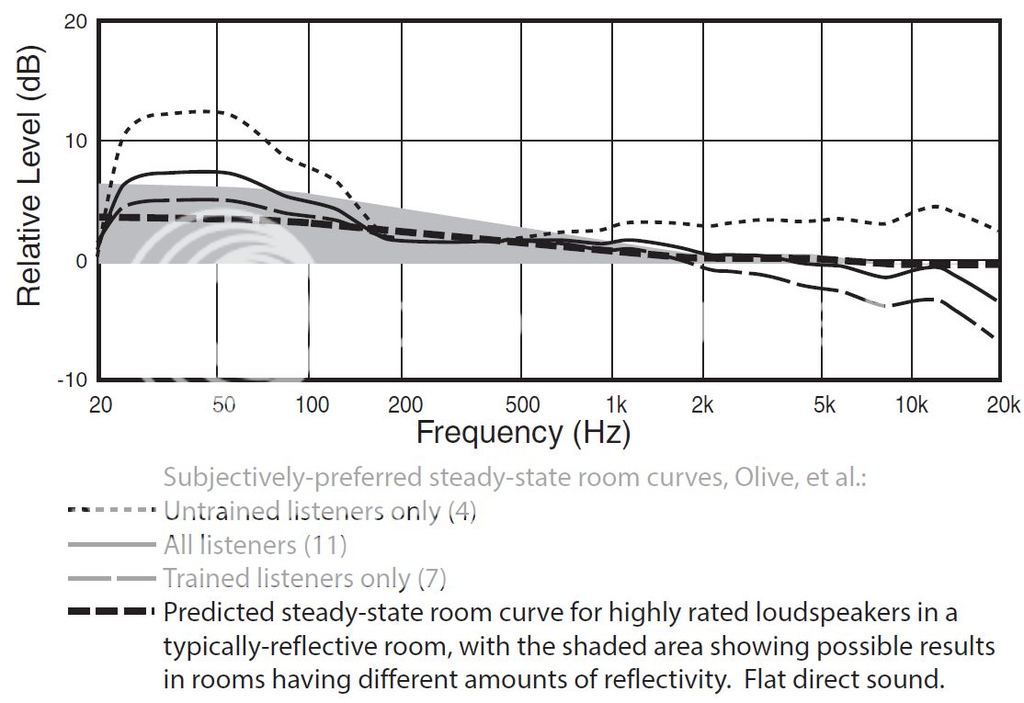I think Dirac uses +2/-2 from 30 Hz to 20 kHz, take a look at this thread...
|
There's the Bob Katz method flat to 1khz then linear diagonal to Nyquist which makes it about -7db 20khz. Some like a bit of bass boost but you need to watch your headroom. You could Google Harman curve for some info on that method.
|
Human beings can hear 0.1dB so the maximum tolerable variance is at most +/- 0.05dB, and I would go .01 just to be sure. Remember, sound quality is 110% entirely determined by frequency response. It is totally worth whatever EQ it takes to get this dialed in. EQ circuits do not alter sound in any way other than to make it perfect.
|
I agree a flat line response would be magnificent, but I doubt it's even achievable in a room.
I'm interested in what others have been able to acheive and I'd love to see their graphs.
My feeling is that digital EQ is not even worth considering if you are serious about music and a graphic equlaizer is superior, although it generally only has 31 bands, so it's somewhat limited in what can be achieved.
|
@millercarbon :
Remember, sound quality is 110% entirely determined by frequency response.
Are you serious??
|
Um yeah. Your system should measure flat to within .01dB or it will be unlistenable. EQ does not alter sound except to make it perfect. I am totally serial.🙄
Is that the eye-roll? I can never figure out which one is the eye-roll.
|
Theory is great, but we should be considering what's achievable in our listening rooms.
|
|

Here is a typical target house curve. I have similar results but I don't do a bass boost. Ignore the nonsense about measurements flat to .01db he has the slightest idea what you're talking about.
|
Au contrere mon frere I have not the slightest idea what you’re talking about.
That chart by the way, says right on the graph that is the Harman audio test system. This is the system they use to test their customers. If you think this is flat enough they know how much they can charge and you’ll never hear the difference. There are exceptions, but double-blind testing has proven to within statistical margins of error that all audiophiles are able to detect irony, the only question being the threshold level. In this case we may have to go to Spinal Tap 11.
PS- please verify you are not a robot.
R.Daneel Olivaw
|

I thought this would be right up everyone's alley on this site since they are Subjective preferences. At any rate house curves are all subjective but there's no way any in room response will measure flat to .01db. Feel free to post one. Why insult Asimov ?
|
My feeling is that digital EQ is not even worth considering if you are serious about music and a graphic equlaizer is superior,
Easy way to measure use REW and an approved microphone. Graphic equalizer is not far superior for home use, you'll get much better results using digital room correction.
|
I only have Audyssey and it might give a smoother frequency response, but I find the SQ isn't as good.
|
|
Yes, that to me wouldn’t be very listenable, to hot in the high frequencies. I prefer a curve like Katz described, fairly flat to 1khz then a slope to 20khz very similar to the Harman curve without the bass boost. Of course it's also speaker dependent above 500hz it's mainly the speaker in control , you need a good speaker that measures flat in an anechoic chamber.
|
Too true. I was looking more at the ripples of the overall frequency response as a way to understand acceptable variations.
|
I don't understand the statement that sound quality is 110% determined by frequency response.
That's impossible.
|
Even if we accept 110% is used as an alternative to "absolutely 100%" the statement is wrong as sound quality is far more than just frequency response.
I also don't agree with the statement maximum tolerable variance is at most +/- 0.05dB, and I would go .01 just to be sure. Might be good with amplifiers, but not for speakers and certainly not for listening position.
From our favourite protagonist/antagonist? Wind him up and he nuts you.
|
Most amplifiers go to 10. So when they're playing and they need a little extra, where do they go? Nowhere. That's why ours go to 11.
If this doesn't clear it up for you remember the immortal words of Bruce Dickenson:
|
Maximum is maximum and it makes no different if the control has 10, 11 or even 12 positions.
|